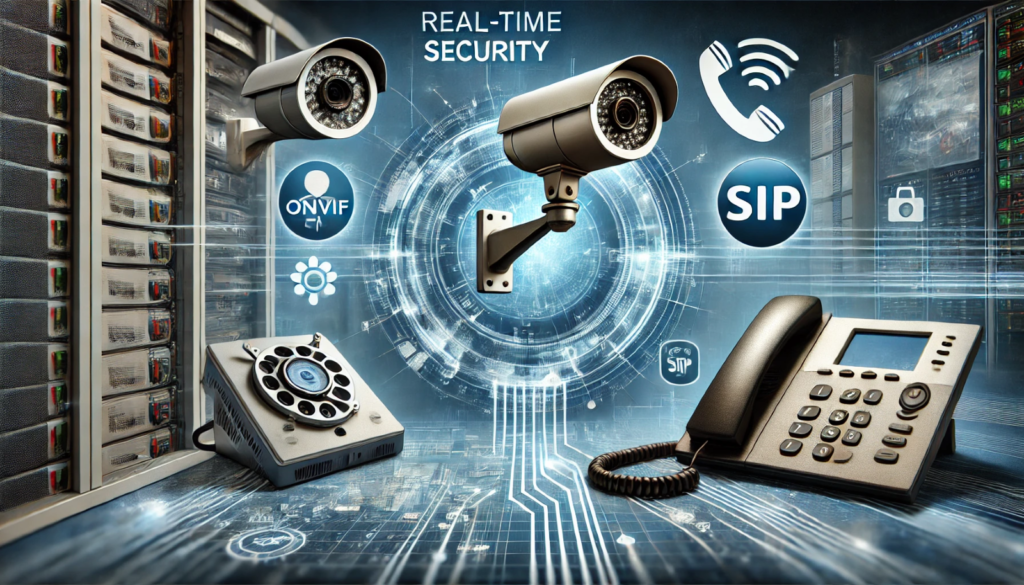In today’s fast-paced world, security and communication systems need to work in real-time, across diverse hardware, and at scale. Two standards, ONVIF (Open Network Video Interface Forum) and SIP (Session Initiation Protocol), are at the forefront of this evolution. As of March 2025, these technologies are driving interoperability and responsiveness in industries like retail, smart buildings, and public safety. This blog explores how these protocols solve critical challenges, their real-world applications, and what lies ahead.
The Problem: Fragmentation and Real-Time Demands
Security and communication systems often suffer from fragmentation. Cameras from one vendor might not integrate with a video management system (VMS) from another due to proprietary protocols. Meanwhile, real-time communication, like alerting staff during a security breach, requires seamless coordination between video and voice. Without standardized frameworks, businesses face vendor lock-in, delayed responses, and costly custom integrations.
ONVIF and SIP address these pain points head-on:
- ONVIF standardizes how IP-based security devices (cameras, recorders, VMS) talk to each other, ensuring interoperability.
- SIP enables real-time session management for voice, video, and messaging, bridging communication gaps.
Together, they create a unified ecosystem where video surveillance and communication operate in sync, delivering actionable insights instantly.
How ONVIF and SIP Solve It ?
ONVIF: Unifying Video Surveillance
- Founded in 2008, it now boasts over 25,000 compliant products as per 2024 conformance stats. It uses profiles, like Profile T for H.265 streaming or Profile M for analytics, to standardize device behaviour.
- How It Works: ONVIF-compliant cameras send video and metadata (e.g., motion detection) to any ONVIF-compatible VMS, regardless of brand. This eliminates compatibility woes and speeds up deployment.
SIP: Enabling Real-Time Communication
- SIP, a cornerstone of VoIP, powers over 1 billion endpoints globally in 2025, according to IETF updates. It initiates and manages sessions, handing off media to protocols like RTP.
- How It Works: SIP connects devices, like a video intercom to a security desk, ensuring low-latency audio/video calls triggered by events.
.
Real-Time Industry Applications
- Retail Security with Verkada: Verkada’s Command platform uses ONVIF to integrate hybrid cloud cameras, while SIP powers real-time alerts to staff phones during incidents like shoplifting.
- Smart Buildings with Axis Communications: Axis’s A8207-VE Mk II intercom leverages ONVIF for video feeds to a VMS and SIP for tenant-guard communication, deployed in smart complexes globally.
- Public Safety with Eagle Eye Networks: Eagle Eye’s cloud VMS uses ONVIF for camera management and integrates SIP-based calls for first responders, as seen in their 2025 municipal deployments.
These examples show ONVIF and SIP converging to deliver real-time video and voice, critical for industries needing instant situational awareness.

Pros and Limitations
Pros of ONVIF:
- Interoperability: Works with thousands of devices, reducing vendor dependency.
- Scalability: Supports massive deployments, like Verkada’s 100+ camera setups.
- Flexibility: Profiles evolve—Profile D (2024) now includes access control integration.
Limitations of ONVIF:
- Partial Compliance: Some devices only support older profiles, missing features like analytics.
- Network Dependency: Real-time streaming demands robust bandwidth, a challenge in remote areas.
Pros of SIP:
- Real-Time Efficiency: Sub-second call setup, ideal for emergencies.
- Wide Adoption: Integrates with platforms like Zoom or Asterisk effortlessly.
- Versatility: Supports video, voice, and messaging in one protocol.
Limitations of SIP:
- Implementation Variance: Vendor-specific quirks can disrupt seamless integration.
- Security Risks: Unencrypted SIP calls are vulnerable, encryption (e.g., SIPS) is a must but adds overhead.
Conclusion
What We’ve Covered:
We’ve explored how these two protocols tackle fragmentation and real-time needs in security and communication. ONVIF unifies video devices, while SIP ensures instant voice/video connections, powering applications from Verkada’s retail security to Axis’s smart intercoms and Eagle Eye’s public safety solutions. Their strengths—interoperability, scalability, and efficiency—are tempered by challenges like partial compliance and network reliance, but their impact in 2025 is undeniable.
The Future of ONVIF and SIP:
Looking ahead, ONVIF is poised to expand into AI-driven analytics (Profile M updates expected in late 2025), enhancing real-time threat detection. SIP, meanwhile, will likely integrate deeper with 5G networks, slashing latency further—imagine sub-100ms emergency calls tied to video feeds. As cloud adoption grows, both standards will underpin hybrid systems, blending on-premises and remote capabilities. The synergy of ONVIF and SIP will remain a linchpin for industries chasing smarter, faster security solutions.

